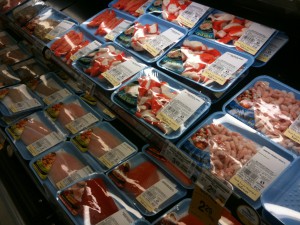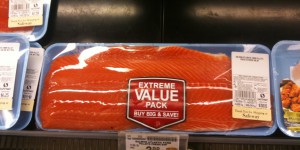 How can we make sustainable seafood choices? Nothing beats a beautiful buttery grilled salmon, shrimp pasta, or fresh sushi, its healthy and tastes great, yet I often feel guilty and confused when I look to purchase my fish. The Foodie series is organized through Assiniboine Park programs and offers two hour workshops to learn and taste a variety of foods and wines. I recently attended an evening devoted to sustainable seaside looking at seafood choices and what we can do about it. I decided that this educational meal would be a good use of my time.
How can we make sustainable seafood choices? Nothing beats a beautiful buttery grilled salmon, shrimp pasta, or fresh sushi, its healthy and tastes great, yet I often feel guilty and confused when I look to purchase my fish. The Foodie series is organized through Assiniboine Park programs and offers two hour workshops to learn and taste a variety of foods and wines. I recently attended an evening devoted to sustainable seaside looking at seafood choices and what we can do about it. I decided that this educational meal would be a good use of my time.
Our speaker presented an array of resources highlighting some of the top issues relating to seafood consumption. We learned about the problems facing Aquaculture (think farmed fish tanks off the coast) and overfishing. On one hand fish pens are a great alternative to feeding the demand for fish, but can be extremely destructive to the surrounding area and spread disease to wild populations. The increased level of antibiotic use in farmed fish also puts the method into question. But on the other hand, overfishing is causing a major depletion of wild fish species. In fact, over 25% of fish stocks are currently being fished faster than they can reproduce.
But I digress; we were there for a good time. The objective here is not to present a series of depressing messages about the state of our oceans but rather to focus on the positive actions that are taking place, helping consumers make responsible choices in order to ensure we can continue to enjoy the bounty of the sea. We went through a comprehensive list of the most common farmed and caught fish and shellfish. Using the various labeling and sustainable standardization systems, we learned which fish were okay to eat and which we should avoid. Because of organizations like OceanWise.ca, blueocean.org, friendofthesea.org, and the David Suzuki Foundation, sustainability charts and ranking codes are helping people make smarter choices. The David Suzuki Foundation offers a top 10 picks to consider when choosing seafood. Take a look
Some further tips and explanations of the fishing industry can help you to understand the state of things.
Salmon

Farmed Fresh Salmon available at Safeway
Open net pen fish farms such as those used for Atlantic Salmon are destructive to the mangroves and wetlands where the pens are set up. Further, the high quantities of fish meal needed to feed the salmon are put at risk of extinction themselves. If you look to buy farmed salmon, choose Alaskan Salmon as they are in high supply due to good management. Your best bet is to go for wild Pacific Salmon. Although the scarcity of the fish is a problem, wild caught is somewhat less destructive than farmed. Check out this article from David Suzuki on current developments of the Salmon farming industry right here in Canada.
Shrimp
Shrimp harvest is a problem due to the amount of bycatch from the bottom trawling nets that scrap the bottom of the ocean floor. Bycatch is the unintended fish and plant life caught by the trawling nets, sometimes up to 90% of the catch is thrown back into the sea leaving the eco-system permanently damaged. Farmed shrimp on the other hand is not recommended because the pens are carved out of coastal areas and damage the surrounding coral and other sea creatures. If you can find hand-caught shrimp or spot prawns (which is what we ate as a ceviche – absolutely delicious!) then you know that you are encouraging a proper and responsible manner of catching them.
Shellfish
As far as acceptable farmed seafood, your best bet is options such as shellfish like scallops, mussels, clams and oysters, which are farmed on lines or trays suspended from rafts and are actually helping to filter organic matter in the ocean.
Trout and Char
Inland, closed system farms are another good alternative and include species such as rainbow trout, tilapia, channel catfish, sturgeon, and Arctic char. As we munched away on our stealcut trout and mussels we learned about the more often than not mislabelling of seafood, a new wave of traceability of seafood and which can of tuna is better to buy. For more tips on simplifying your seafood decisions, check out this article in the Winnipeg Free Press from last year.
So, what can you do?

Safeway is showcasing the SeaChoice label system and promises to offer only sustainable seafood choices by 2015.
What I left the event with, other than a full belly and a few new bottles of wine from sustainable wineries in Ontario, was the importance of asking questions and creating a culture of accountability. First, consider opting for more veggie filled meals and slow down the demand for seafood. But if you are inclined to buy some fish, the next time you are at the counter, ask the clerk where the fish is from, how it was caught and if it has been labeled a sustainable fish. The clerk may not know the answer, so then politely ask them to find out for the next time you come to buy fish. The message will hopefully make it to their manager, and the manager will take it to the supplier head office and suddenly the demand for sustainable fisheries has increased. Your purchase and your voice is your vote. Corporations will not change if they think people don’t care. If we all start asking questions about where our seafood comes from and how it was caught, and showing that we care about what we are eating, then the culture will shift.



Recent Comments